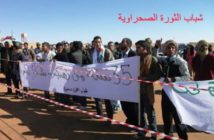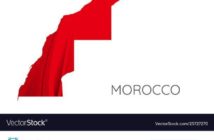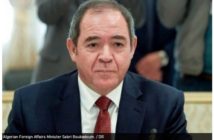The not-so publicized 36-year-old simmering conflict between Morocco and the disputed territory of Western Sahara is causing new concerns as radical elements further destabilize North Africa and the disaffected Sahrawi population loses patience.

Camel-crossing sign in Western Sahara. All photos by Larisa Epatko.
BY LARISA EPATKO
Larbass Abid, a Sahrawi, was born in Laayoune — Western Sahara’s largest city and its capital — in 1983. His people have been seeking independence from Morocco since 1976, when Spain abandoned its colonial claim. He’s one of the younger Sahrawis who has taken up the disputed territory’s independence struggle, going as far as helping organize a massive protest in 2010.

That year, thousands of Sahrawis moved into tents in the outskirts of Laayoune to protest what they considered harsh living conditions, job discrimination and little compensation from the sale of their natural resources.
“The protest camp was a reaction to the marginalization of the Sahrawi voice,” Abid told a group of visiting reporters in December. “It was an accumulation over the years, and people couldn’t stand it anymore,” he said through a translator.
The camp, called Gdeim Izik, lasted for 28 days before Moroccan authorities cleared out everyone, dismantled the camp and burned the remains. Now all that’s left is an empty, rocky plain with a police outpost.
The Moroccan government refutes the notion that Sahrawis are discriminated against, saying strict laws are in place to protect their rights. And spokespeople contend the government is the largest provider of jobs for all people who live in Western Sahara — Moroccans and Sahrawis alike.
But leaders of the Polisario, the leadership of Western Sahara, are worried young Sahrawis might turn to violence if they feel their needs aren’t being respected.
“This is the second generation born under this situation,” Bucharay Beyoun, Spain’s Polisario representative, said recently in Madrid. “They’ve been waiting more than 20 years for a solution, and they’ve reached the point that they’re not willing to wait more time for peaceful solutions and they may move on to other kinds of actions.”
Some are concerned about outside influences, too. Several region watchers cited the violence in neighboring Mali, due to an Islamist uprising against the government, as a destabilizing force on the region.
The flow of weapons from Libya — after the overthrow of Moammar Gadhafi — to Mali and elsewhere makes the entire region more volatile, said Emira Woods, co-director of Foreign Policy in Focus at the Institute for Policy Studies, who specializes in U.S. foreign policy with an emphasis on Africa and the developing world.
People with militant proclivities now have access to these weapons, which allows them to quickly escalate their violent strategies, seen most recently with the kidnappings of gas plant workers in Algeria, she said. “I worry that there will be a domino effect where extremists will gain greater ground.”
That ground might be fertile in the Polisario camps in western Algeria, where thousands of people defying Morocco’s control are living, said Peter Pham, director of the Africa Center at the Atlantic Council. The lack of a resolution to the situation in Western Sahara, after more than three decades, has created a pool of trained fighters in the Tindouf camps of Algeria with nothing to do, he said.
“I’m not saying the Sahrawi people or the Polisario people are terrorists,” but with thousands of well-trained fighters and young men with little economic prospects, it’s a potential recruiting source for al-Qaida, drug traffickers or other negative actors, he said.
After his latest visit to the region in November, the U.N. envoy for Western Sahara, Christopher Ross, said the threat of extremism in the region makes the resolution of Western Sahara’s conflict with Morocco all the more urgent.
“While some may believe that the status quo is stable and that it is risky to take chances for peace, I believe that this is a serious miscalculation — particularly now that the region is threatened by extremist, terrorist, and criminal elements operating in the Sahel,” he said in a press statement.
Ross, who has been envoy to Western Sahara since 2009, has said he is giving up holding informal meetings with the key players together in one room, and instead will meet with the parties one-on-one.
Morocco’s long-term struggle with Western Sahara involves neighboring nations Mauritania to the south and Algeria to the east. Thousands of refugees and the seat of the Polisario government reside just over the border in Algeria.
Though the conflict doesn’t tend to get much mention in the international media, it’s a perennial issue at the United Nations, which is trying to pry some sort of solution from the parties.
It’s also grabbed the attention of some high-profile types, including Spanish actor Javier Bardem, who visited Western Sahara in 2008 for an annual film festival and has been a vocal proponent for the Sahrawis ever since.
Sahrawis contesting Morocco’s control want to hold a referendum on independence, but both sides have yet to agree on the terms of the vote. Their inability to budge makes the conflict an agonizing one for some of those involved at various points.
“It’s hard to see what is going to change,” said Anna Theofilopoulou, a member of U.N. secretary-general person envoy James Baker’s Western Sahara negotiating team in the 1990s. “Both sides use inaction to their advantage,” rather than risk a solution not to their liking.
In the meantime, the United Nations recognizes Western Sahara as a non-self-governing territory, and it is reflected as such on most maps. The United Nations has sent a peace-keeping force known as MINURSO, which is up for an extension this year.
A tangible sign of the conflict is a 1,600-mile-long sand berm that cuts Western Sahara into the Moroccan-controlled west and Polisario-controlled east. Moroccan forces built the sand wall in the 1980s as a shield against the Polisario’s guerrilla fighters. It’s lined with land mines on both sides, which the United Nations and the Moroccan government are now working to remove.
Land of Sand and Rock
Flying toward Laayoune at sunset reveals vast stretches of sand dunes and sporadic clusters of lights marking the fishing villages.
Once on the ground in Laayoune, a city with a population of about 237,000, estimates the CIA World Factbook, one sees mostly salmon-colored concrete buildings and palm tree-lined plazas.

The area is under development, which has accelerated in recent years. Morocco has poured millions into building Laayoune’s first university, swimming pools and commercial complexes. The unemployment rate in Western Sahara is 13 percent, compared to 9 percent in Morocco as a whole, so there’s an effort to increase job opportunities and provide job training as well.
Providing new infrastructure, along with jobs and job training, is not only an effort to address the area’s social needs but a politically strategic move as well.
The region’s governor, Hamid Chariai, told several visiting reporters recently that Morocco’s investment in human capital, along with its other initiatives and reforms, is intended to secure its status as a strategic ally with other countries. “I think this is the reason many governments put their trust in Morocco,” he said through a translator.
It’s a strategy that seems to be paying off. The United States implemented a free trade agreement with Morocco in 2006. Trade between the two countries has grown over the years and topped $3.79 billion in 2011, according to the U.S. State Department.
The European Union also entered an agreement with Morocco to fish in its waters, though the pact was suspended a year ago to reconsider environmental and economic issues and to take into account the interests of the Sahrawi population. The EU is reportedly working on re-negotiating the terms of the agreement.
Natural Resources as a Driver in the Debate
Western Sahara has several ports feeding into the Atlantic Ocean. It has fish-laden waters and a phosphate mine that hasn’t made a profit in years, but holds much potential as global demand grows for this integral ingredient to fertilizer.
The phosphate rock mine is in Boucraa, southeast of the city of Laayoune. It’s operated by a private subsidiary of the Moroccan government, OCP (an acronym derived from its French name, the Office Cherifien des Phosphates). It produces about 2.5 million tons of phosphates per year. At $185 per ton, that’s a value of about $463 million.

The phosphate rock, once washed, is delivered via the longest conveyor belt in the world — 62 miles — to the port of Laayoune, where it’s poured into waiting vessels and shipped to other countries with facilities that turn it into fertilizer.
Morocco has two other mines in the northern part of the country. The United States and China have more mines than Morocco, but they tend to keep their phosphates for their own use, making Morocco the world’s largest phosphate exporter.
Sahrawis want a share of that revenue, since one of the mines is in their territory, and a say in dealings with foreign entities. But since Western Sahara isn’t a sovereign country, Morocco makes the deals.
The United Nations supports the Sahrawis’ stance, to a certain extent. In 2002, when asked about Moroccan exploration of mineral resources in Western Sahara, U.N. legal counsel Hans Corell said based on the United Nations’ guidelines for non-self-governing territories, if mineral extraction was done against the wishes of the Sahrawi people, it would be considered in violation of international law.
When asked about this legal opinion and Morocco’s continued mining, Minister of Communication Mustapha Khalfi said Corell’s decision also recognizes Morocco as the administering authority in the region.
Khalfi said the government’s budgets and investments in resources are reviewed by local, municipal and regional councils in Laayoune. And the Moroccan government can’t implement international agreements without the ratification of the parliament, which has 52 Sahrawi members, he said.

Many Sahrawis still feel they are missing out on the value of natural resources they say are theirs. The discontent is felt at a national as well as individual level. Nafae Eddia, a resident of Laayoune, said he first applied for a fishing license in 2008 and was promised one at that time, but he never received it.
It was frustrating to see other people, mainly those who recently moved to Laayoune from northern Morocco, get their licenses instead, Eddia said. He attributed the difference to their identification cards, which show the owner’s place of birth, allowing those who issue permits to take that information into account.
Eddia said he eventually gave up on the fishing license, went to school to become a mechanic, but is currently unemployed.
Minister Khalfi said it’s against the law to discriminate against anyone, so if people feel they’re being treated unfairly they can take their cases to court, he said. “The constitution is clear in Article 35 to guarantee … equality in terms of the people who would like to invest.”
The government is working to resolve problems of transparency and license distribution, not only in the fishing sector but in transportation and other areas, in order to enhance investment, said Khalfi. He added that Moroccan King Mohammed VI said in a November speech that he would like to see a regional model for economic development in the Sahara to give its people more of an opportunity to develop their economy.
Some pro-Sahrawi activists acknowledge the government’s efforts but say more needs to be done. As the Gdeim Izik protest camp was cleared out in November 2010, violence broke out, including the reported knifing deaths of 11 Moroccan police officers and the retaliatory arrest and beating of hundreds of Sahrawis. Their family members and friends had trouble finding out what happened to them, which only fueled their anger.
Sahrawi activist Salha Boutangiza, 28, said besides being jailed, punishments can come in other ways. She said after trying to organize students to her cause, she’s been black-listed and now can’t get a job. But “it was worth it” she said at a friend’s home.

In general, Sahrawis, who are mainly Muslim, pride themselves in being peaceful and accepting of different cultures and faiths: “We even like Israel,” one person told the visiting reporters. But there’s a difference of opinions on whether their protests will remain peaceful and whether outside militant influences will bleed over into Western Sahara.
Ambassador Yilma Tadesse, the African Union’s senior representative to MINURSO, agreed that the “problem can no longer be left to fester,” citing Mali as a growing regional threat. A military coup in Mali in March 2012 toppled the government and allowed armed groups including al-Qaida in the Islamic Maghreb to take over the north.
The discord between Western Sahara and Morocco is hurting the region economically, said Tadesse. When countries can’t meet at the heads-of-state level, it’s difficult for the Maghreb (Northwest Africa) region to make progress, he said.
The African Union itself is all but impotent in the disagreement. Morocco dropped out of the organization after Western Sahara became a member. “Morocco would rather not see us get involved with the day-to-day consultations, so the U.N. envoy has taken over that responsibility,” Tadesse said.
Then why stay? Because it’s an “African problem,” said Tadesse. “Both Morocco and the Polisario are ours. This is almost like a family problem and we want it to be solved.”
Amid all the warnings were some words of hope. History teacher Mohamed Mayara, 37, said although Sahrawis have waited more than 25 years for a referendum, he still thought it eventually would happen with some outside help. “The threat of terrorism is a big push to the international community to resolve this,” he said.
A Moroccan member of the military, who asked that his name not be published, said he thought the religion of Islam, which they all shared, would hold them together.
But while talking in the home of the aforementioned activist, Larbass Abid, one of his friends burst into the room saying there were a number of security guards gathered outside and he was nervous. One of the activists’ concerns is the close monitoring of government security forces to the point of intimidation, and the presence of reporters might have attracted more attention than usual.
“It’s boiling,” Abid said of the fever some in Western Sahara feel. “If it goes on like this, the Sahrawi people will do something a lot bigger than the protest camp.”
This report was produced on a trip arranged by the International Women’s Media Foundation. Browse all of the NewsHour’sWorld coverage and follow us on Twitter.








